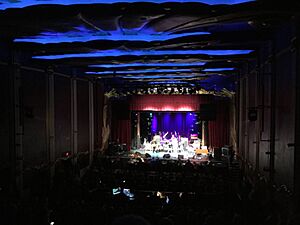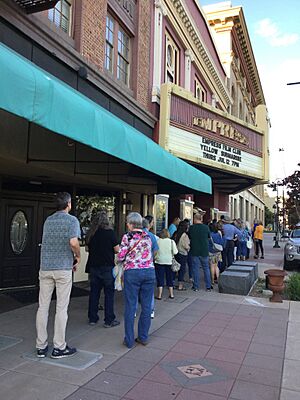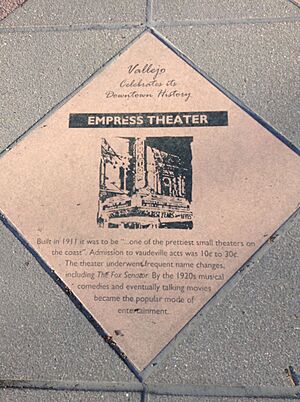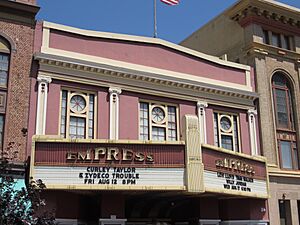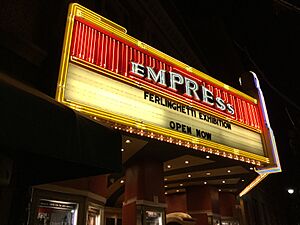Empress Theatre (California) facts for kids
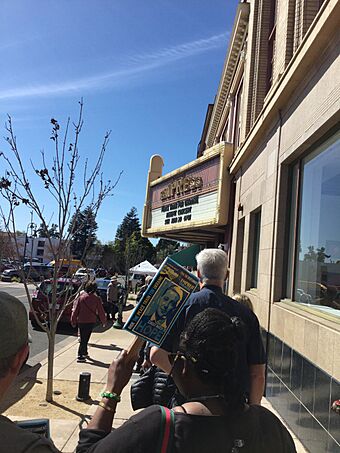
Empress Theatre
|
|
| Location | 330 Virginia Street, Vallejo, California 94590 |
|---|---|
| Coordinates | 38°06′08″N 122°15′28″W / 38.10223°N 122.25767°W |
The Empress Theatre is a historic building in downtown Vallejo, California. It was first built in 1911. After being closed for almost 20 years, it reopened in 2008. The closure happened after the big 1989 Loma Prieta earthquake.
This old movie house has been fully updated and made safe from earthquakes. Today, it is run by a group that doesn't make money for itself. The theatre shows movies, hosts live performances, and can be rented for private events.
Contents
A Look Back: The Empress Theatre's Story
The Empress Theatre has a long and interesting history. It has changed names and owners many times. Each change brought new life and new shows to the stage.
The First Empress Theatre (1911-1912)
- 1911: The theatre was built by a group called the Independent Order of Odd Fellows. They named it the Empress Theatre. A local architect named William A. Jones designed the building. It had two levels, gold-leafed clouds on the ceiling, and red velvet seats. There was even a pipe organ! The first managers were Abe Marks and Gus Cohen from San Francisco. People thought it would be "one of the prettiest small theatres on the coast."
- 1912: The Empress Theatre opened its doors on February 14. It started with a vaudeville show. Vaudeville was a popular type of entertainment with different acts like comedy, music, and dance. There were two shows every night, plus extra shows on Saturdays and Sundays. The theatre had 940 seats. Tickets cost 10¢, 20¢, or 30¢. Ushers, who helped people find their seats, wore cool red military uniforms with gold trim.
The Republic Theatre (1913-1915)
- 1913-1915: A new company, the Bert Levey Circuit, took over. They wanted to make more money. To avoid confusion with another theatre they owned, they changed the name from the Empress to the Republic.
The Vallejo Theatre (1916-1928)
- 1916: The theatre's lease was given to Thomas O'Day. He spent $5,000 to make the theatre better. It reopened as the New Vallejo Theatre. Guests enjoyed brand new, comfy cushion seats.
- 1920: A time called the Prohibition era began in the United States. During this time, it was against the law to make, sell, or transport alcohol. This era lasted for 13 years. During Prohibition, musical comedies and later, "talking movies" (movies with sound), became very popular forms of entertainment.
The Fox Senator Theatre (1929-1951)
- 1929: A large theatre company called Fox West Coast Theaters took over. They completely updated the inside of the building. They spent $20,000 to install new equipment for "talking pictures." This brought the theatre into the modern age, and vaudeville shows became less popular. On October 24, 1929, a day known as Black Tuesday, the U.S. stock market crashed. This event started The Great Depression, a very difficult economic time.
- 1930: On March 28, 1930, a terrible fire badly damaged the theatre. It caused about $50,000 worth of damage. Only the main support beams and outside walls were left. Fox West Coast thought about closing the theatre for good. But after looking at the burned building, they saw that it could be rebuilt. So, Fox West Coast decided to take on the challenge.
- 1931: Most of the inside of the theatre was rebuilt. They changed how people walked through the theatre and how the seats were arranged. This made it similar to other Fox theatres. They added a bright neon sign outside. They also added new restrooms and special rooms for men and women. The theatre's main structure, stage, and some of the old decorations were kept. The building reopened as the Fox Senator Theatre. It no longer showed stage plays, focusing only on movies.
- 1951: After World War II, Fox Theatre management found a faster way to update their theatres. They wanted to create "deluxe movie houses." The company created its own design team. They updated about 200 of their theatres to have new looks. These updates included bright signs, shiny aluminum panels, and special display cases. They also added ticket booths that looked like juke boxes. The inside decorations had wavy shapes, fancy drapes, and cloud-like gold designs. These designs were meant to draw your eyes toward the screen. The Fox Senator's lobby, entrance area, and main seating area were all updated.
The Crest Theatre (1952-1979)
- 1952: Ray Syufy bought the theatre and renamed it "The Crest." It showed movies on a single screen. It closed ten years later.
- 1978: Between 1962 and 1978, the building was not well cared for. It was then bought by the Elliot family, who had strong ties to Vallejo.
The Empress Returns (1980-2003)
- 1980: The Elliott family worked hard to bring the theatre back to its 1950s look. The golden clouds on the ceiling returned, and the theatre got its original name back: the Empress. The outside of the building was repainted. The "Empress Theatre" sign was painted above the entrance. Old window panels were uncovered and fixed. Seats from other Fox Theatres were saved and put in. Gold decorations were re-gilded, and new carpets were laid. The Empress was very popular throughout the 1980s.
- 1989: On October 17, a powerful earthquake, measuring 6.9 on the moment magnitude scale, shook the San Francisco Bay Area. This was the Loma Prieta earthquake. The Empress Theatre was damaged. Fixing the earthquake damage and making the building safe was a huge job. Because of this, the theatre sat empty and unused for almost 20 years.
- 1990: The Empress Theatre was officially named Vallejo Landmark #17. This means it is an important historic building.
- 2000-2003: The building was bought and sold a few times between 2000 and 2003. Eventually, Triad Communities bought the theatre. They planned to redevelop it with the City of Vallejo and the Vallejo Community Arts Foundation.
Saving and Restoring the Empress (2004-2008)
- 2004: The Empress was bought by Empress Theatre Associates LLC (ETA). This was a special partnership between ETA, the City of Vallejo, and the Vallejo Community Arts Foundation (VCAF). The official start of the restoration work happened in April.
- 2006: Under Triad's guidance, the theatre was carefully restored. They made it safe from earthquakes while keeping its historic look and charm. They also updated the stage design and the heating, ventilation, and air conditioning systems. The lobby and restrooms were greatly improved. All 471 seats in the main seating area were replaced, and much more was done.
- 2007: On May 8, the new bright sign (marquee) outside the theatre was tested for the first time. On June 11, Empress Theatre Associates LLC received approval from the City Council for federal tax credits. These credits helped them get back some of the money spent on the renovation. A national non-profit organization also helped them get more tax credits to cover costs.
- 2008: The Empress Theatre officially reopened with a regular schedule of performances in the spring of 2008.
- 2014: As planned, the ownership of the Empress Theatre was given to the City of Vallejo. This happened after a required period related to the tax credits.

All content from Kiddle encyclopedia articles (including the article images and facts) can be freely used under Attribution-ShareAlike license, unless stated otherwise. Cite this article:
Empress Theatre (California) Facts for Kids. Kiddle Encyclopedia.

